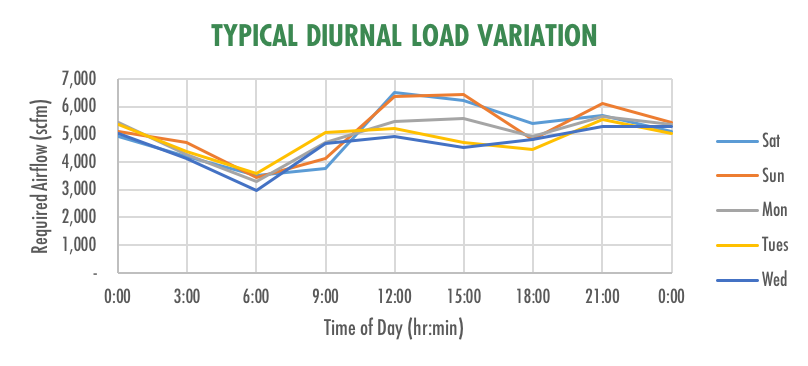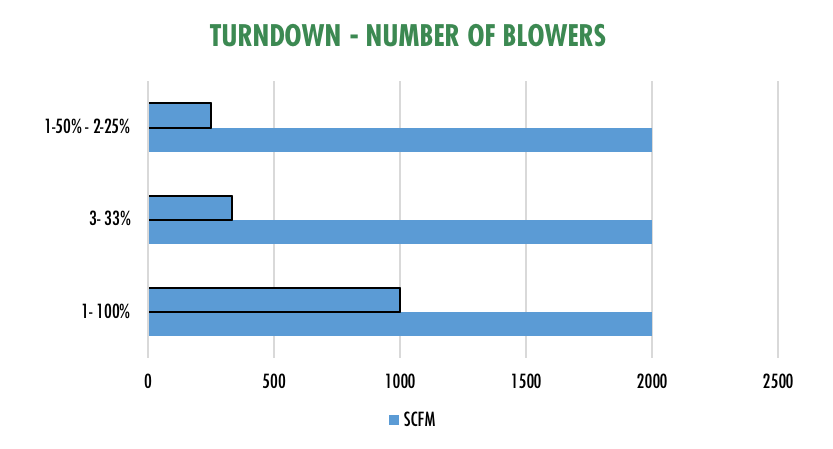Turndown
Inovair Turndown Capability
Turndown is a term often heard when discussing the operation of blowers. Understanding what turndown is and the effect of turndown on blower performance and plant operation are crucial for an optimally designed energy efficient aeration system. Turndown is the operating range of a blower and blower system and is expressed as a percentage. Typical blower turndown is 25-60%, dependent on the blower type. Multi-stage centrifugal blowers offer limited turndown, however since this is normally achieved with an inlet butterfly valve, their power consumption does not drop proportionally to the reduced flow. Positive displacement blowers offer good turndown, but can over heat and offer reduced efficiency at lower flows. High-speed centrifugal blowers normally provide 40-60% turndown, dependent on their control method and aerodynamic design.
Typical blower turndown is 25-60%, dependent on the blower type. Multi-stage centrifugal blowers offer limited turndown, however since this is normally achieved with an inlet butterfly valve, their power consumption does not drop proportionally to the reduced flow. Positive displacement blowers offer good turndown, but can over heat and offer reduced efficiency at lower flows. High-speed centrifugal blowers normally provide 40-60% turndown, dependent on their control method and aerodynamic design.
It is ideal to have a minimum turndown of 50% (2:1) to eliminate a dead zone or hunting for individual blowers, and at least 75% (4:1) for the blower system. The greater the turndown the more flexibility the plant has in handling unexpected demands.
Since most plants blower systems were designed for the future and for the worst case condition the blower system is often oversized. Many times the minimum flow required for the lowest demand times and/or the *coldest day of the year was not designed into the blower system. This means the maximum flow capacity of each blower was much greater than currently needed the majority of the time. Thus having the ability to turndown the blowers is crucial in reducing energy costs and maintain process control.
Turndown is also important to understand for the blower system as a whole because of diurnal flows at many Waste Water Treatment Plants (WWTP). The required air flow demand for the blower system can vary quite dramatically as peak daytime loads can be two times greater than nighttime loading. Without the ability to turndown to meet these lower demands the utility wastes air and thus energy.
 Additionally excessive dissolved oxygen (DO) can negatively affect process performance. For example carry-over DO may impact de-nitrification in the anoxic zones of a BNR plant.
Additionally excessive dissolved oxygen (DO) can negatively affect process performance. For example carry-over DO may impact de-nitrification in the anoxic zones of a BNR plant.
Historically it was common to use two large blowers each designed to meet the maximum design capacity. One would run while the other would be stand by. There would be only 25-50% turndown available with this design. Because of the issues mentioned earlier the operating blower would overate the majority of the time and waste energy. Even if these blowers were replaced with higher efficiency blowers, during low flow periods the blowers would still over-aerate and waste energy. Not having enough turndown could actually limit the energy savings of the more efficient blowers.
Because of the desire to realize all the benefits of more efficient blowers and maintain process control it is now common to use four blowers with the maximum design capacity met with three blowers running each designed to meet 33% of the design flow. This configuration provides over 80% turndown. This option not only provides more flexibility but energy savings.
Another approach would be to use two larger and two smaller blowers. Having two blowers at 50% (one stand by) of the design flow and two blowers at 25% of the design flow would provide nearly 90% turndown. This option would provide superior turndown capability while reducing energy further.
 The historical methods and design limiting factors can negatively affect an aeration system if turndown is not adequately understood and accounted for. Taking into to account the worst case scenarios for both minimum and maximum flows and utilizing efficient and properly configured blowers will ensure the aeration system runs in control and as efficiently as possible.
The historical methods and design limiting factors can negatively affect an aeration system if turndown is not adequately understood and accounted for. Taking into to account the worst case scenarios for both minimum and maximum flows and utilizing efficient and properly configured blowers will ensure the aeration system runs in control and as efficiently as possible.
*Because blowers are constant volume machines, cold air is denser so the blower actually delivers more SCFM for the same ICFM in at night or in the winter because of the colder air
 Typical blower turndown is 25-60%, dependent on the blower type. Multi-stage centrifugal blowers offer limited turndown, however since this is normally achieved with an inlet butterfly valve, their power consumption does not drop proportionally to the reduced flow. Positive displacement blowers offer good turndown, but can over heat and offer reduced efficiency at lower flows. High-speed centrifugal blowers normally provide 40-60% turndown, dependent on their control method and aerodynamic design.
Typical blower turndown is 25-60%, dependent on the blower type. Multi-stage centrifugal blowers offer limited turndown, however since this is normally achieved with an inlet butterfly valve, their power consumption does not drop proportionally to the reduced flow. Positive displacement blowers offer good turndown, but can over heat and offer reduced efficiency at lower flows. High-speed centrifugal blowers normally provide 40-60% turndown, dependent on their control method and aerodynamic design. It is ideal to have a minimum turndown of 50% (2:1) to eliminate a dead zone or hunting for individual blowers, and at least 75% (4:1) for the blower system. The greater the turndown the more flexibility the plant has in handling unexpected demands.
Since most plants blower systems were designed for the future and for the worst case condition the blower system is often oversized. Many times the minimum flow required for the lowest demand times and/or the *coldest day of the year was not designed into the blower system. This means the maximum flow capacity of each blower was much greater than currently needed the majority of the time. Thus having the ability to turndown the blowers is crucial in reducing energy costs and maintain process control.
Turndown is also important to understand for the blower system as a whole because of diurnal flows at many Waste Water Treatment Plants (WWTP). The required air flow demand for the blower system can vary quite dramatically as peak daytime loads can be two times greater than nighttime loading. Without the ability to turndown to meet these lower demands the utility wastes air and thus energy.
 Additionally excessive dissolved oxygen (DO) can negatively affect process performance. For example carry-over DO may impact de-nitrification in the anoxic zones of a BNR plant.
Additionally excessive dissolved oxygen (DO) can negatively affect process performance. For example carry-over DO may impact de-nitrification in the anoxic zones of a BNR plant. Historically it was common to use two large blowers each designed to meet the maximum design capacity. One would run while the other would be stand by. There would be only 25-50% turndown available with this design. Because of the issues mentioned earlier the operating blower would overate the majority of the time and waste energy. Even if these blowers were replaced with higher efficiency blowers, during low flow periods the blowers would still over-aerate and waste energy. Not having enough turndown could actually limit the energy savings of the more efficient blowers.
Because of the desire to realize all the benefits of more efficient blowers and maintain process control it is now common to use four blowers with the maximum design capacity met with three blowers running each designed to meet 33% of the design flow. This configuration provides over 80% turndown. This option not only provides more flexibility but energy savings.
Another approach would be to use two larger and two smaller blowers. Having two blowers at 50% (one stand by) of the design flow and two blowers at 25% of the design flow would provide nearly 90% turndown. This option would provide superior turndown capability while reducing energy further.
 The historical methods and design limiting factors can negatively affect an aeration system if turndown is not adequately understood and accounted for. Taking into to account the worst case scenarios for both minimum and maximum flows and utilizing efficient and properly configured blowers will ensure the aeration system runs in control and as efficiently as possible.
The historical methods and design limiting factors can negatively affect an aeration system if turndown is not adequately understood and accounted for. Taking into to account the worst case scenarios for both minimum and maximum flows and utilizing efficient and properly configured blowers will ensure the aeration system runs in control and as efficiently as possible.*Because blowers are constant volume machines, cold air is denser so the blower actually delivers more SCFM for the same ICFM in at night or in the winter because of the colder air
